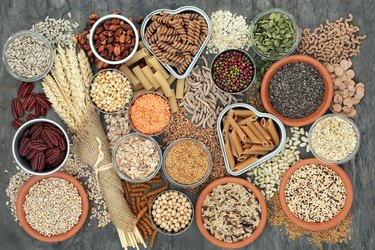
Most of us sometimes wonder if we're really getting the nutrition we need from the food we eat. It can be hard to know for sure when it comes to calories, carbs, fat, protein and sodium.
Fortunately, the U.S. Food and Drug Administration helps us figure it out by requiring every food package to list how much of the recommended daily amounts of essential nutrients comes in each serving. (The values are based on an average person burning 2,000 calories a day.)
Video of the Day
Video of the Day
Here's more help sorting out where you stand on meeting the nutritional benchmarks your body needs.
Get the Right Amount of Calories
Your recommended daily intake (RDI) of calories depends on three main factors: your activity level, age and sex.
The U.S. Department of Health and Human Services' 2020-2025 Dietary Guidelines provides these estimated calorie needs: About 1,800 to 3,000 per day, depending on your height, metabolism, level of physical activity and assigned sex at birth.
Our basal metabolic rate (a measure of how many calories the body burns at rest) tends to lower as we age, according to the American Council on Exercise, so we generally need fewer calories the older we get. And, of course, the more calories we burn via exercise, the more we need to take in to maintain our current weight.
Choose Healthy Carbs

Carbohydrates come from starches, sugar and fiber. Your carbohydrate RDI is 45 to 65 percent of your total calories. The exact number depends on your activity level, because your body uses carbs as fuel.
Nutritious sources of carbs include whole fruit, whole-grain breads and cereals, nuts, beans and legumes. The fiber found in most of these nutritious sources of carbohydrates helps improve bowel health, lower cholesterol and regulate blood sugar, according to the Mayo Clinic.
For adults on a 2,000-calorie-a-day diet, 900 to 1,300 of those calories should come from carbohydrates, which should include 28 to 30 grams of fiber, according to the Dietary Guidelines.
Monitor Your Fat Intake
Fats are necessary in a healthy diet. A high fat intake is more than 35 percent of your calories, while a low intake is less than 20 percent.
Monounsaturated and polyunsaturated fats are beneficial to your health because they help to even out cholesterol levels, facilitate the efficient production of hormones and aid in your body's absorption of vitamins. These types of fats are plentiful in nuts, cold-water fish such as salmon, seeds like flax and chia, avocados and olive oil.
The Dietary Guidelines recommend limiting saturated fats — found in fatty beef, lamb, processed meats like bacon and sausage, butter and cheese — to no more than 10 percent of your daily calorie intake. Saturated fat, per the American Heart Association, raises the level of LDL cholesterol in your blood, which can lead to heart disease or stroke.
Don't Skimp on Protein

Protein is the main structural component of all cells in your body, so it's an important nutrient. The protein in your food breaks down into amino acids during digestion, which your body uses to repair and build new tissue.
Your protein RDI varies by age, sex and calorie intake, and ranges from 46 to 56 grams per day, per the Dietary Guidelines. Go-to sources of protein can include lean meat and skinless poultry, beans, nuts, eggs and seafood.
Limit Sodium
The sodium RDI is less than 2,300 milligrams per day for adults, equal to about 1 teaspoon of salt, according to the Dietary Guidelines. But most people are getting too much — more than 3,400 milligrams on average, according to the Centers for Disease Control and Prevention.
Taking the salt shaker off your table will not limit your sodium intake as much as you might think. Most of our sodium intake comes from prepared foods. "The 'salty six' are some of the biggest offenders," says Ilana Buchbinder, RDN, a dietitian based in Long Island, New York. "Those are breads and rolls, cold cuts and cured meats, sandwiches, pizza, canned soup and prepared chicken."
Buchbinder recommends trying new spices to flavor food and reduce sodium intake. She likes cinnamon and curry powder on lean meats, for example. "Of course, cooking homemade soup is a great way to get the canned stuff out of your kitchen," she adds. "And when you do buy packaged foods, it's always a good idea to carefully read nutrition labels and choose foods that are low in sodium."
- American Heart Association: "Saturated Fat"
- Mayo Clinic: "Dietary Fiber"
- National Institutes of Health: "Closing America's Fiber Gap Intake"
- U.S. Department of Health and Human Services: "Appendix 7"
- U.S. Department of Health and Human Services: "2020-2025 Dietary Guidelines"
- American Council on Exercise: "Is it true that metabolism decreases with age?"
- 2015-2020 Dietary Guidelines: "Appendix 2. Estimated Calorie Needs per Day, by Age, Sex, and Physical Activity Level"
- Mayo Clinic: "Dietary fiber: Essential for a healthy diet"
- 2015-2020 Dietary Guidelines: "Appendix 7. Nutritional Goals for Age-Sex Groups Based on Dietary Reference Intakes and Dietary Guidelines Recommendations"
- American Heart Association: "Saturated Fat"
- Centers for Disease Control and Prevention: "Get the Facts: Sodium and the Dietary Guidelines"
Was this article helpful?
150 Characters Max
0/150
Thank you for sharing!
Thank you for your feedback!